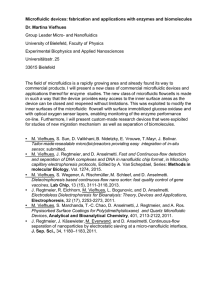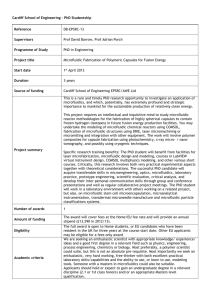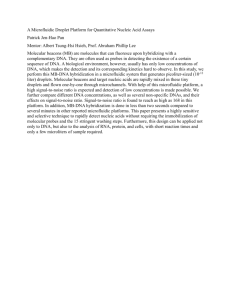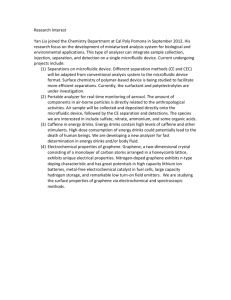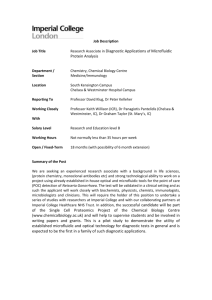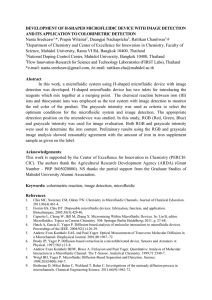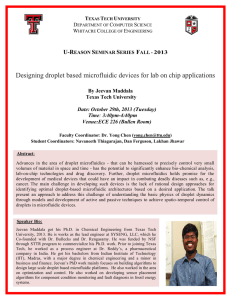A microfluidic device to control bio actuators of
advertisement
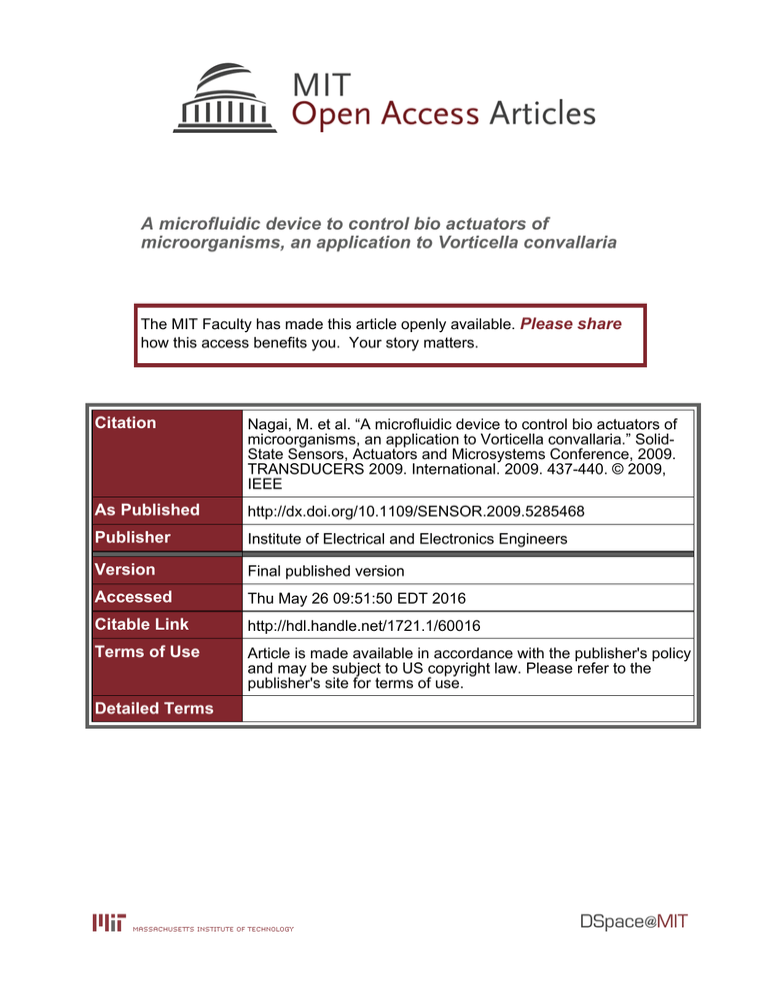
A microfluidic device to control bio actuators of microorganisms, an application to Vorticella convallaria The MIT Faculty has made this article openly available. Please share how this access benefits you. Your story matters. Citation Nagai, M. et al. “A microfluidic device to control bio actuators of microorganisms, an application to Vorticella convallaria.” SolidState Sensors, Actuators and Microsystems Conference, 2009. TRANSDUCERS 2009. International. 2009. 437-440. © 2009, IEEE As Published http://dx.doi.org/10.1109/SENSOR.2009.5285468 Publisher Institute of Electrical and Electronics Engineers Version Final published version Accessed Thu May 26 09:51:50 EDT 2016 Citable Link http://hdl.handle.net/1721.1/60016 Terms of Use Article is made available in accordance with the publisher's policy and may be subject to US copyright law. Please refer to the publisher's site for terms of use. Detailed Terms M3P.105 A MICROFLUIDIC DEVICE TO CONTROL BIO ACTUATORS OF MICROORGANISMS, AN APPLICATION TO VORTICELLA CONVALLARIA M. Nagai1, S. Ryu2, 3, T. Thorsen2, P. Matsudaira2, 3, and H. Fujita1 1 CIRMM, IIS, The University of Tokyo, Tokyo, JAPAN 2 Massachusetts Institute of Technology, Cambridge, Massachusetts, USA 3 Whitehead Institute for Biomedical Research, Cambridge, Massachusetts, USA lack of a sophisticated control system such as the blood circulatory system in humans. In typical bio assays, solutions are manually changed with pipettes; this is slow and tedious. An automatic control system is desired to utilize the motor of Vorticella in MEMS. The goal of this study is to develop a microfluidic platform to manipulate the biomolecular motors by using micro valves to change the type and concentration of the solution [5]. ABSTRACT We demonstrate a microfluidic device to control the motion of Vorticella convallaria by changing solution. Floating cells of V. convallaria were injected and cultured inside the device. Approximately 35 cells of V. convallaria in 102 nl of the solution. The cells were treated with saponin solution and controlled with a microfluidic device. When reaction solution was switched, the stalk contracted and relaxed corresponding to the ambient calcium ion concentration change. The length of the stalk changed between 40 and 60 μm, resulting in a working distance of about 20 μm. METHOD To control V. convallaria, we fabricated a pneumatic microfluidic device (figure 2) controlled via computer, solenoid valves and a compressor. The microfluidic device has three main components: 1) chambers to contain cells of V. convallaria. 2) flow channels and inlets to introduce V. convallaria and chemical reagents to the chambers. 3) control channels to select chambers and inlets by manipulating valves. KEYWORDS Vorticella, Microfluidic valve, Biomolecular motor INTRODUCTION Although MEMS (Micro Electro Mechanical Systems) is a powerful tool in air or vacuum, the application of MEMS, especially actuators, in aqueous environment is limited. Magnetic micromixer can work in water, however, a driving circuit is necessary, which causes the size of total system enlarges. One solution to the problems is to employ the micrometer-scale motors from biological systems. Micro-organisms have their own actuators and control mechanisms functioning effectively in water. Recently we showed an idea to employ a ciliate protozoan, Vorticella as a micromixer [1]. Hiratsuka et al. rotated a microrotary motor composed of a 20-μm-diameter silicon dioxide with the use of bacterium Mycoplasma mobile [2]. Borrowing the well-adapted functions of the organism is beneficial and can result in the elimination of external driving sources. We have identified a suitable biological motor in Vorticella convallaria capable of delivering high levels of force and displacement. This ciliate protozoan has a contractile stalk tethering the cell body to a substrate. A filament inside the stalk contracts and relaxes depending on the concentration of calcium ions as Fig. 1 shows. Contraction of live V. convallaria takes less than 10 msec [3]. After stalk membrane is permeabilized with detergent, ions can penetrate the sheath of the stalk, making both contraction and relaxation of V. picta controllable by adjusting ambient calcium concentration [4]. In this way, Vorticella can be used as a linear actuator that responds to calcium ion concentration. One problem of using such a biological motor is the 978-1-4244-4193-8/09/$25.00 ©2009 IEEE Figure 1: Micrographs and schematic representation of the motility of Vorticella. Vorticella contracts and relaxes in response to the concentration change of calcium ion. 1 2 3 4 5 In1 Ch1 In2 Ch2 In3 Ch3 In4 Ch4 6 7 8 Outlet Figure 2: A schematic of the microfluidic device. The microfluidic device has three main components: 1) chambers (Ch1-Ch4). 2) flow channels and inlets (In1-In4). 3) control channels (1-8). 437 Transducers 2009, Denver, CO, USA, June 21-25, 2009 Microfluidic control device were prepared by the process of multilayer soft lithography using PDMS (Sylgard 184, Dow Corning) [6]. The microfluidic device is composed of two elastomer layers (flow and control layer). Devices were fabricated using the push-up valve configuration. For the flow layer fabrication, a 50 μm thick layer of positive tone AZ 50 XT (Clariant) was patterned on a silicon wafer. After development, the AZ was reflowed by placing the wafer on a hotplate at 120 °C to create channels with round cross sections followed by a hard bake overnight at 130 °C. The control wafer was created using two layers of 50 and 100 μm thick SU8 50. The second layer of SU8 was patterned over the base layer where valves and chambers were located. The shape of a chamber is similar to cuboidal. The dimensions of each chamber are 150 μm high, 2.5 mm long and 1.0 mm wide. One chamber is designed to have 367 nl of the volume. Molds were treated with silane to facilitate PDMS casting. The flow and control layers of the device were cast and thermally bonded at 80 °C using 5:1 and 20:1 PDMS, respectively. After curing of the two layer device for several hours, we punched interconnection holes between flow channels and chambers with a scalpel under the stereomicroscope. Input ports were punched with biopsy tools and chips were cleaned using ethanol and nitrogen. Individual control chips were bonded to precleaned 1 mm thick glass slides using a 30 s air plasma treatment on target surfaces (Expanded Plasma Cleaner, Harrick Plasma, Ithaca, NY). Steel pins and tubes were connected to the device. Flow channels and chambers were fulfilled with solutions. Ca2+ (a) Vorticella introduction (b) Attachment & growth (c) Chelator of Ca2+ (d) Ca2+ Chelator Figure 4: A picture of the microfluidic device. Eight tubes for the control channel and four tubes for the inlet are connected. To test the operation of switching solutions of the device, we filled the chambers with green dye and replaced green dye with water inside the chambers. We applied different pressures to eject green dye and measured the speed of exchanging solution. We used ImageJ software for image analysis and processing to calculate green area. Floating cells of V. convallaria were obtained for injection to the device in the following manner. V. convallaria were cultured in Petri dishes. After suitable number of V. convallaria grew, the cells were scraped from the bottom of the Petri dishes. We centrifuged them at 3000 g, and the supernatant was discarded to enrich the cells. V. convallaria were introduced and controlled in the microfluidic device as shown in figure 3. (a) We injected the floating cells into chambers. (b) We kept them for two days to attach to the surface and to grow stalks. Then we injected 0.1 % (w/w) saponin in rinse buffer (0.1 M NaCl, 4 mM EGTA, 50 mM Tris-HCl, pH 6.8) and waited for 20 minutes until the cells were permeabilized. (c) The rinse buffer was injected to wash out detergent. To control the contraction and relaxation of stalks, we alternately applied two solutions: rinse buffer as chelator for relaxation and (d) calcium ion solution, Ca2+ ion in rinse buffer, the value of free Ca2+ ion was adjusted to 1.0 μM for contraction. Solutions were kept injecting during the operation. We observed their motion and length under a stereomicroscope. Switching Figure 3: A Schematic of the experimental procedure to control V. convallaria in the microfluidic device. 438 RESULTS&DISCUSSION Figure 4 shows a picture of the fabricated microfluidic device. Eight tubes for the control channel and four tubes for the inlet are connected. The size of interconnection holes is around 0.1 mm2. The valves were controlled with solenoid valves, and solution was switched from green to transparent (figure 5 and 6). The green solution was fulfilled up to an area of approximately 2.3 mm2. Then, the green area gradually disappeared as water replaced it. The middle area of the chamber is initially flushed away. Then, the remaining dye at the perimeter of the chamber is washed away. The delay (a) 0.0 s (b) 0.1 s (c) 1.0 s (d) 2.0 s (e) 3.0 s (f) 4.0 s (g) 5.0 s (h) 7.0 s (i) 9.0 s (j) 11.0 s (k) 13.0 s (l) 15.0 s 2.5 Green Area [mm2 ] in liquid replacement at perimeter as compared to center is determined by the location of the inlet and outlet and the dimensions of the chamber. Exchanging rates of solutions are characterized by analyzing the green area (figure 6). The exchanging rates become large with increasing applied pressure. The green area of the each graph decrease exponentially with time and is saturated at around 0.3 mm2 because of the remaining bubble in the chamber. The curves are presumed to be linear in the range of 1.0—2.3 mm2. We calculated and obtained the exchanging rates from 2.3 to 1.0 mm2 (table 1). The minimum and maximum exchanging rates are 18.0 nl/s at 6.9 kPa and 127 nl/s at 34 kPa. Solution containing cells of V. convallaria was gradually injected as shown in figure 7. Approximately 35 cells of V. convallaria were in 102 nl of the solution. When 10 kPa was applied, the volume of the solution increased from 102 nl to 141 nl in 90 s (table 2). A few hours after the injection, almost all cells attached the surface inside the chamber. The attachment of the cells was strong enough to flow, and the cells did not detach from the surface. Two days after the injection, V. convallaria have several dozen μm of stalks (figure 8). We observed V. convallaria were alive 5 days after injection. Since chambers and channels are not filled, injection rate is slower than the chamber is already filled. After treatment of saponin solution, V. convallaria stopped their spontaneous motion, and V. convallaria is controlled with a microfluidic device. Figure 9 shows a time series of the length of a stalk. When the solution is switched, the stalk contracts and relaxes corresponding to the ambient calcium ion concentration change. The length of the stalk is repeatedly shrank and elongated in the range between 40 and 60 μm, resulting in a working distance of about 20 μm. The transition from contraction to relaxation (and vice versa) finishes in about two seconds. After the valves are switched, the entering solution reaches the location of the V. convallaria with a delay of about 5-10 seconds. 6.9 kPa 14 kPa 21 kPa 28 kPa 34 kPa 2 1.5 1 0.5 0 0 10 Time [s] 20 30 Figure 6: Time courses of green area depending on applied pressures (6.9 to 34 kPa).Exchanging rates are described in table 1. Table 1: Exchanging rates from the initial value of 2.3 mm2 to 1.0 mm2 at different pressures. Applied Pressure 6.9 14 21 28 34 [kPa] Exchanging 60.5 86.5 127 18.0 32.2 Rate [nl/sec] (a) (b) (c) (d) Figure 7: Times series of injection of cells of V. convallaria into a chamber. (a) 0 s, (b) 30 s, (c) 60 s, and (d) 90 s at 10 kPa. Volumes of solution in each image are shown in table 2. Scale Bar: 500 μm. Table 2: Volume change of the solution at 10 kPa from 0 s to 90 s. Time (a) 0 (b) 30 (c) 60 (d) 90 [s] Volume of the 102 115 129 141 Solution [nl] Figure 5: Optical micrographs of a chamber during switching solution from green to transparent. The applied pressure of the inlet is 21 kPa. There are some air bubbles at the top right of the chamber. The green area is also cited in figure 6. Scale Bar: 1mm. 439 ACKNOWLEDGEMENT This work has been supported in part by the 2008 International Training Program (ITP) of Japan Society for the Promotion of Science (JSPS) granted to Institute of Industrial Science, the University of Tokyo. We acknowledge the financial support from the University of Tokyo Global COE Program “Secure-Life Electronics.” REFERENCES Figure 8: V. convallaria in a chamber. Scale bar 200 μm. Length of stalk [μm] 70 [1] M. Nagai, M. Oishi, M. Oshima, H. Asai, and H. Fujita, "Three-dimensional two-component velocity measurement of the flow field induced by the Vorticella picta microorganism using a confocal micro-PIV technique," Biomicrofluidics, in press. [2] Y. Hiratsuka, M. Miyata, T. Tada, and T. Q. Uyeda, "A microrotary motor powered by bacteria," Proc Natl Acad Sci U S A, vol. 103, pp. 13618-13623, 2006. [3] A. Upadhyaya, M. Baraban, J. Wong, P. Matsudaira, A. van Oudenaarden, and L. Mahadevan, "Power-limited contraction dynamics of Vorticella convallaria: An ultrafast biological spring," Biophysical Journal, vol. 94, pp. 265-272, 2008. [4] T. Ochiai, H. Asai, and K. Fukui, "Hysteresis of Contraction-Extension Cycle of Glycerinated Vorticella," Journal of Protozoology, vol. 26, pp. 420-425, 1979. [5] T. Thorsen, S. J. Maerkl, and S. R. Quake, "Microfluidic large-scale integration," Science, vol. 298, pp. 580-584, 2002. [6] M. A. Unger, H. P. Chou, T. Thorsen, A. Scherer, and S. R. Quake, "Monolithic microfabricated valves and pumps by multilayer soft lithography," Science, vol. 288, pp. 113-116, 2000. Ca2+ 60 50 Chelator 40 30 20 10 0 0 20 40 60 Time [s] Figure 9: A time series the length of a stalk while the solutions are injected alternately at 14 kPa. The stalk contracts and relaxes in response to the concentration change of calcium ion. Blue and red arrows indicate the time switching the valves to inject chelator and Ca2+ solution. CONCLUSION We fabricated a microfluidic device to control the motion of V. convallaria by changing solution. The microfluidic device has three main components: 1) chambers to contain cells of V. convallaria. 2) flow channels and inlets to introduce V. convallaria and chemical reagents to the chambers. 3) control channels to select chambers and inlets by manipulating valves. Solution in a chamber is exchanged with solenoid valves and a compressor. One chamber is designed to have 367 nl of the volume. Floating cells of V. convallaria were injected. Approximately 35 cells of V. convallaria were in 102 nl of the solution. A few hours after the injection, almost all cells attached the surface of the chamber. Two days after the injection, the cells had several dozen μm of stalks. V. convallaria was controlled with a microfluidic device. When the solution was switched, the stalk contracted and relaxed corresponding to the ambient calcium ion concentration change. The length of the stalk changed between 40 and 60 μm, resulting in a working distance of about 20 μm. The microfluidic device is promising for a control device of biomolecular motors. We are also investing the process to combine V. convallaria in MEMS. Contact * M. Nagai, tel: +81-3-5452-6249; moeto@iis.u-tokyo.ac.jp 440
